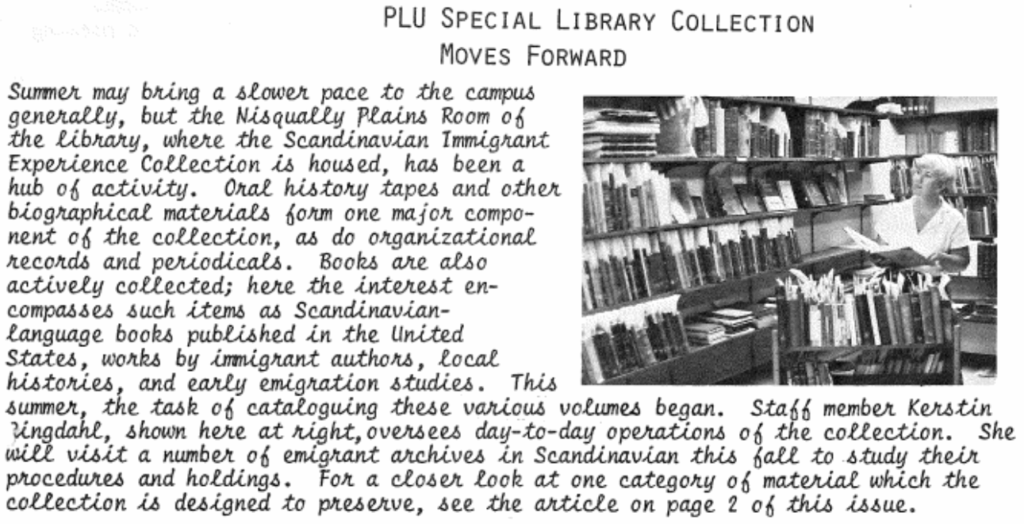📰From the Vault: Origins of the Scandinavian Immigrant Experience Collection

August 1981, Vol 4 No. 1: Immigrant Libraries – About to disappear?
Crumbling paperbacks, laden with dust, line the wall of the outdoor shed. Olaf Sivertsen, alert and lively at 97, reminisces as the books are taken from the shelves, one by one, and placed in cartons for transport to the PLU library.
The books were purchased by Olaf from a Scandinavian bookdealer in Tacoma more than sixty years ago. They were eagerly read, and then graciously shared with friends. But their useful days within the social circle are now long gone. The old Norwegian volumes hold little interest for younger members of the family. Many times such book collections are simply discarded. When this happens, it is a considerable loss. The personal libraries of Scandinavian immigrants like Olaf Sivertsen urgently need to be saved.
Such volumes, faded and foreign as they may seem to the casual observer, hold a store of valuable information for researchers and for future generations. Surveyed as separate collections, the books highlight the interests and perspectives of individual immigrants and their families. Surveyed together, the collections help pinpoint the dominant cultural values of Scandinavian-Americans and chart the course of Scandinavian ethnic identity. Each publication tells a bit of the story. The Chicago reprint of a Swedish Romantic poet shows the continuity of the literary classics. The Danish translation of The Count of Monte Cristo testifies to the universal desire for escape and adventure. The well-worn devotional guide, carried across the Atlantic, witnesses to a strong and steady faith. Immigrant libraries hold the key to analyzing much of the literary activity which occurred within the ethnic community. The Scandinavians had barely settled in their new homeland before ethnic presses began to roll in places like Tacoma and Seattle. Much remains to be learned about which authors were favored and which works saw frequent new editions, as well as about the new authors who emerged from among the immigrant ranks.
This information may be lost, unless quick action is taken. The material is often in precarious physical condition. The paper and binding are fragile and the natural process of disintegration has in many cases been hastened by neglect or by poor storage conditions. Fewer and fewer persons read the Scandinavian languages with ease. Even fewer can decipher the old orthography and the Gothic script in which the majority of the volumes are printed. Understandably, there is a tendency to discard deteriorating and unintelligible materials. The process is further hastened by the fact that in the Northwest the first generation of Scandinavian immigrants are now past 70. Their libraries often disappear upon the move to a retirement home or when the family divides the estate. Time is bringing the immigrant era to a close and with it the passing of the physical conditions of that era.
At PLU conscious steps are being taken to preserve immigrant library materials and organizational records. If you know of such documents, please bring them to our attention.


